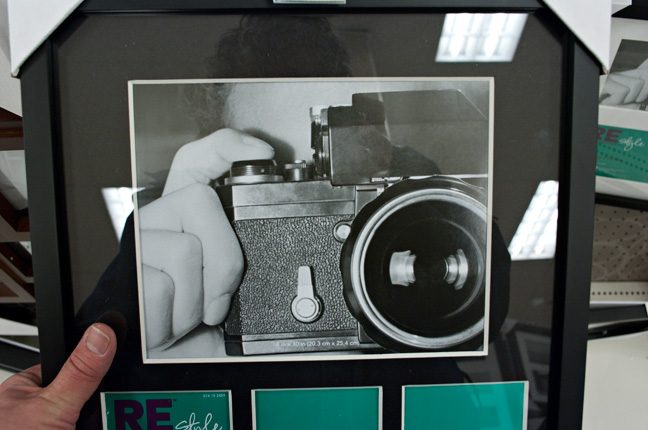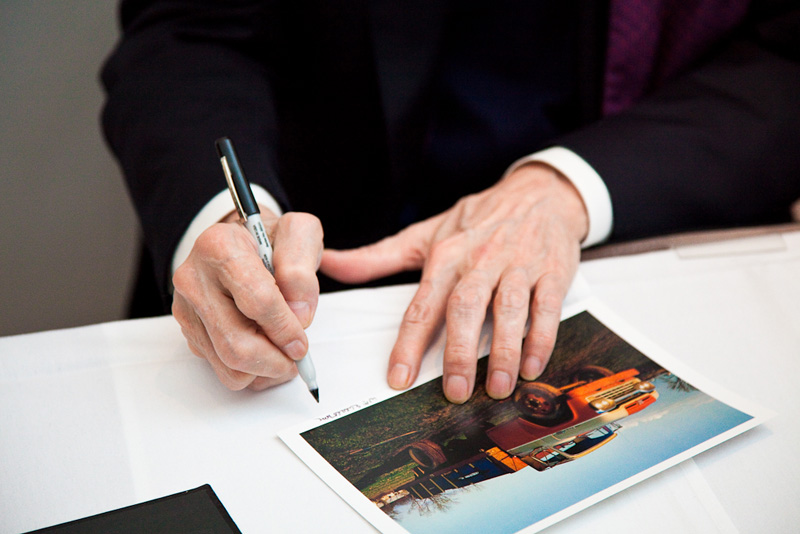
Tyler Monson ran across this in the picture-frame aisle at Target. "Obviously a Nikon F (Photomic T) but note the position of the model's finger—on the top of the shutter advance lever and not the shutter release next to it! Thought it might amuse you." Always. Prop-meisters, do thy homework!
-

Mark Kinsman made it down to the opening of the big Eggleston show at the Art Institute of Chicago. While waiting in line to get his copy of William Eggleston's Guide autographed, he took this shot of Eggleston signing a picture. The show runs until May 23 in the new Modern Wing, and I will definitely be going.
If you don't have the Guide, you ought to. Love it or hate it (and I'll warn you, there are those who hate it), it's one of the two or three dozen most important and influential photography books of the past sixty years. When you limit the category to photography in color, it moves into the top dozen. Eggleston, the apotheosis of the snapshot, edited by Szarkowski, the most astute and astringent of art photography's connoisseurs. A happy confluence and one of those books I treasure. The original is worth $400 now, give or take, but the "facsimile" edition is just as good to look at, and you can buy yours clean and new and untouched, for now.
Mike
(Thanks to Tyler and Mark)
Send this post to a friend
Note: Links in this post may be to our affiliates; sales through affiliate links may benefit this site. More...



So, what is the difference between the two versions of William Egglestons' Guide on Amazon? One is referred to as a facsimile, the other not, and published separately by two different houses about a month apart. Or is there not actually any difference?
Posted by: Jerry Thirsty | Monday, 01 March 2010 at 06:55 PM
Jerry,
So far as I know there are only two, both published by the Museum of Modern Art, the first edition from 1976 and the second edition from 2002, for which new separations were made. I've never directly compared the repro in the two editions, but both looked fine to me when seen separately.
Mike
Posted by: Mike Johnston | Monday, 01 March 2010 at 07:25 PM
It was a marvelous show and the signing was a thrill. For another capture of Eggleston, visit:
http://www.pbase.com/lsolum/eggleston_in_chicago
Posted by: Lawrence Solum | Monday, 01 March 2010 at 08:44 PM
Why would some people hate this book?
Posted by: philippe | Monday, 01 March 2010 at 09:39 PM
Hmm... well, Mike, that begs the question -- what _are_ the "two or three dozen most important and influential photography books of the past sixty years"? :) Some (many?) of us would love a post on the subject (with color-only as a derived sub-category).
Cheers,
--Geoff
Posted by: Geoff Smith | Monday, 01 March 2010 at 10:01 PM
I took a shot of that ridiculous photo frame last year:
http://www.flickr.com/photos/rawhead/3364120102/
like I comment there, I'm not shocked that the male model got it wrong, but what about the friggin' PHOTOGRAPHER that shot that image??? Didn't s/he see immediately that there was something clearly wrong with that picture??? :lol:
Posted by: RawheaD | Monday, 01 March 2010 at 10:11 PM
Mike,
One of the things that struck me about your definition of "art" a few weeks ago was the concept of depth. Going back and looking at favorite photographs, in many of them I could not identify "a deeper meaning". I began to think that what I was thinking of as art was really craft, and I can appreciate that just as much. However, you also describe Egglestons' work as "art", and once again in most of it I cannot see "depth", just great photographs. Now I feel like a luddite who may just never "get it". Is there something obvious that I am missing, or is it something that if it needs to be explained, then I just don't have it?
Posted by: Roger Engle | Monday, 01 March 2010 at 10:16 PM
Mike,
Thanks for the post of the image - quite a pleasant surprise. I also have several other images of William and the surround exterior of the exhibit, including a few of him actually signing my copy of the Guide. This one was an opportunity I could not pass up.
Love him or hate him, it is a show worth seeing at least once. They also have a very nice exhibit book - although a bit pricey at $70.00 for non-members. It is an oversized coffee-table book, which, I believe, contains all the images in the show. The show takes up the entire first floor of the Modern Wing.
Best regards,
Mark
P.S. I will be posting a few more images on the Flickr pages as soon as I get a round tuit.
Posted by: Mark Kinsman | Monday, 01 March 2010 at 10:20 PM
I adore Eggleston--a hero. I highly recommend the terrific documentary available on Netflix.
Posted by: J. Robert Lennon | Monday, 01 March 2010 at 10:22 PM
Nice shot, Mark!
Yes, the Eggleston show is really lovely and quite large, spanning the special exhibits gallery in the Modern Wing as well as the new Bucksbaum Photography Gallery across Griffin Court.
Indeed, Eggleston was able to attend Friday's opening night festivities. It was a somewhat unexpected treat to discover him at the Lenders' Dinner! He was also cruising about the big Evening Associates party held following the dinner. (William -loves- to party!) Few of the young people attending the party seemed to give a crap about seeing the exhibit...they were there to "network"...but William didn't care about the photos, either. (He'd already seen them.)
I encourage everyone even vaguely interested to see the show either here at the AIC or at its next, and final, venue the Getty in LA. You're unlikely to see so many of Eggleston's prints exhibited in one venue again (not to mention so many simply wonderful dye transfer prints in a single show). Kate Brussard, the Assistant Curator who crafted this venue's installation, has also done an excellent job of showing various print incarnations of a few of the images...which makes the dye transfer work sing even louder.
"Guide" is fine but it's a very small sampling assembled according to John Szarkowski's curatorial point of view which I feel is far, far too limited and uninformative in this case. You will know nothing of Eggleston or his work after paging through "Guide". In my opinion the catalog for this exhibit, published by the Whitney, is a far better retrospective survey of Eggleston's lifetime of photo work. It's also superbly printed, capturing most of the character of those lickable dye transfer prints.
Posted by: Ken Tanaka | Monday, 01 March 2010 at 10:58 PM
Saw a documentary on Eggleston the other day. He doesn't seem like a very personable kind of fellow, but the pictures, well, they do make up for it.
Posted by: juze | Tuesday, 02 March 2010 at 01:34 AM
Still remember when that book (and exhibit) made its rather controversial debut. I occasionally smoked those popular funny cigarettes at the time, and they really helped enhance the experience for this B&W only guy. Quit that brand of smoke shortly thereafter (for the occasional cigar), but still love the work. And apparently so do countless others since the world of color he helped initiate has changed remarkably little in the thirty plus years since.
Posted by: Stan B. | Tuesday, 02 March 2010 at 01:47 AM
This definitely claims for a list of the "two or three dozen most important and influential photography books of the past sixty years"!
Posted by: Andrea | Tuesday, 02 March 2010 at 05:51 AM
Prop-meisters, do thy homework!
Oh you "Zuchtmeister der Photographen-Zunft" – isn't it our foremost endeavor to create a well composed, visually pleasing, interesting picture? It simply looks better this way.
Ed : )
Posted by: Ed Zork | Tuesday, 02 March 2010 at 06:56 AM
"not a very personable kind of fellow" is a kind understatement. Does being a good artist excuse him all the ugliness in his life? I remember back in the eighties he was riding around wearing an SS uniform, (as reported by American Photographer).
Posted by: charwck | Tuesday, 02 March 2010 at 08:46 AM
I suspect that Eggleston would not take kindly to your description of him as "the apotheosis of the snapshot." Here are his own thoughts on the matter, from his "Afterword" in "The Democratic Forest":
"I am afraid that there are more people than I can imagine who can go no further than appreciating a picture that is a rectangle with an object in the middle of it, which they can identify. . . . They want something obvious. The blindness is apparent when someone lets slip the word 'snapshot.' Ignorance can always be covered with 'snapshot'. The word has never had any meaning. I am at war with the obvious."
I tend to agree with ol' Bill that "snapshot" is a term that ought to be retired -- it has no meaning save a pejorative tone. In contemporary photographic culture, when Eggleston, Nan Goldin, Daido Moriyama, and Wolfgang Tillmans rule a substantial chunk of the art-photo roost, does the term have any use?
Posted by: Yuanchung Lee | Tuesday, 02 March 2010 at 08:58 AM
I have the 2002 version but my favorite image is the one on the front. I always thought it was the best shot of its era - a commentary on the cultural change that affected the last half of the 20th century. The rise of the dominance of the child. I bought the book for that image alone.
Posted by: Barb | Tuesday, 02 March 2010 at 01:09 PM
I don't know if I would hate this book; but I have found the Eggleston prints I've seen to be of very little interest. It seems to me that he's deploying some of the most subtle technology available for color reproduction to deliberately do a bad job that, through the 60s and 70s, anybody could get at the corner drugstore, and anybody serious worked hard to move away from.
Back up to the Nikon in the Target photo frame, I noticed that the other week too. Yes, the finger is definitely wrong (and arguably that illustrates the bad user interface of that model). Also, the brand name has been removed, probably in post-processing (makes sense for this commercial use).
Posted by: David Dyer-Bennet | Tuesday, 02 March 2010 at 01:12 PM
This definitely claims for a list of the ten or so really important photography books of the past fifty years that Mike didn't recognize as such. Hehe.
Posted by: cb | Wednesday, 03 March 2010 at 03:28 PM